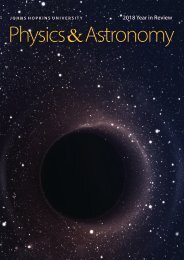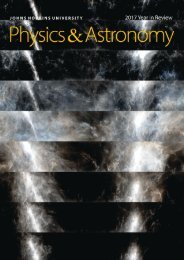2016_PA_Newsletter_12_29_16_FINAL
Create successful ePaper yourself
Turn your PDF publications into a flip-book with our unique Google optimized e-Paper software.
IN MEMORIAM<br />
Remembering James Calvin “Cal” Walker<br />
On January 15, <strong>20<strong>16</strong></strong>, The Johns Hopkins<br />
University lost Professor James Calvin “Cal”<br />
Walker, an emeritus faculty member in the<br />
Department of Physics and Astronomy, to cancer.<br />
Cal Walker was born Jan <strong>16</strong>, 1935, grew up<br />
in North Carolina, and graduated from Harvard<br />
majoring in physics in 1956. After receiving his Ph.D.<br />
in nuclear physics from Princeton, 1961, he came to<br />
Hopkins in 1963 and stayed ever since. He served as<br />
the Chair of the Department from 1987 to 1993. He<br />
also served on the Homewood Academic Council.<br />
Photo courtesy of Ann Finkbeiner<br />
During the 1960s, in the heyday of the study<br />
of recoilless nuclear gamma ray resonances, better<br />
known as Mössbauer spectroscopy, Prof. Walker<br />
made several notable contributions. In particular,<br />
he and his JHU colleagues, Professors Yung K. Lee<br />
and Leon Madansky, pioneered the Mössbauer<br />
effect after Coulomb excitation of the atomic<br />
nucleus, using the Van der Graaf accelerator located<br />
in then Rowland (now Krieger) Hall. In the 1970s<br />
his interest shifted to condensed matter physics, in<br />
particular to ultrathin epitaxial films fabricated by<br />
the then newly developed molecular beam epitaxy<br />
(MBE) technique, which he termed “money-burning<br />
evaporator.” His best-known work probably was in<br />
the area of the magnetic properties of ultrathin iron<br />
(Fe) films. By placing isotopic 57 Fe, (which exhibits<br />
the Mössbauer effect) at different locations in a thin<br />
Fe film made of 56 Fe (which does not), Prof. Walker<br />
and his students were able to map out for the first<br />
time the variation in materials’ magnetic properties<br />
near surfaces with atomic-scale resolution.<br />
Cal was legendary for his love of flying, first<br />
of gliders and later of a variety of powered aircraft.<br />
Some of his colleagues and visitors, and most of<br />
his Ph.D. students, had the<br />
most memorable experience<br />
of their lives with Cal in the<br />
cockpit. His ability to walk<br />
away unscathed from disasters<br />
was equally legendary, as he<br />
survived several serious glider<br />
crashes, and a few forced<br />
landings with the World War II<br />
vintage Taylorcraft that he had<br />
rebuilt with canvas and wood.<br />
Professor Walker had major<br />
impact on the Department of<br />
Physics and Astronomy during<br />
his time as Chair, guiding the<br />
department’s move to its current<br />
home in the Bloomberg Center<br />
for Physics and Astronomy,<br />
and playing a leading role in<br />
numerous faculty hires during a<br />
time of important growth for the<br />
department. His tireless efforts<br />
and can-do attitude during<br />
this time were crucial in setting the department<br />
on the path it has followed in the past 25 years.<br />
We extend our deepest sympathy to Cal’s wife<br />
Ann Finkbeiner, whose interest in our department, and<br />
unique perspective as a leading science writer have<br />
greatly enriched our academic and personal lives.<br />
Cal’s colleagues and friends will always<br />
remember his immense energy and enthusiasm, and<br />
his complete unwillingness to accept that anything<br />
he set his sights on could not be accomplished.<br />
We have lost a colorful and unique colleague.<br />
<strong>16</strong> JOHNS HOPKINS UNIVERSITY PHYSICS AND ASTRONOMY <strong>20<strong>16</strong></strong>










